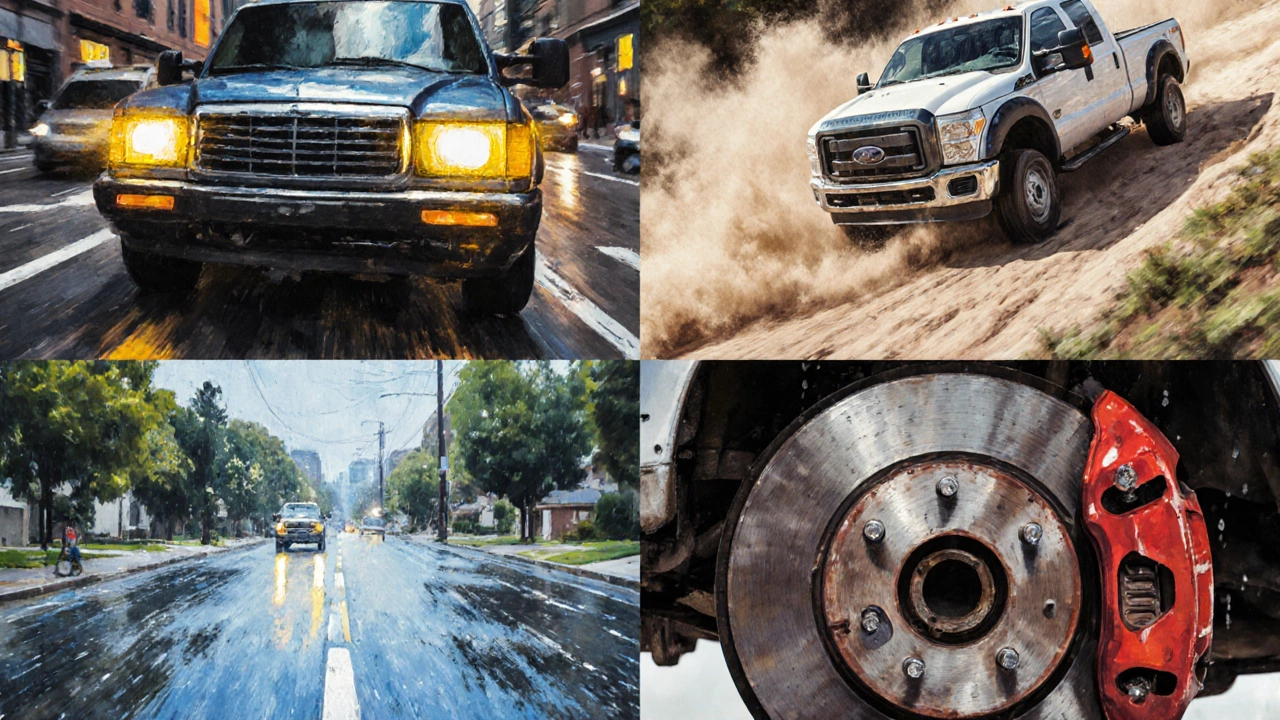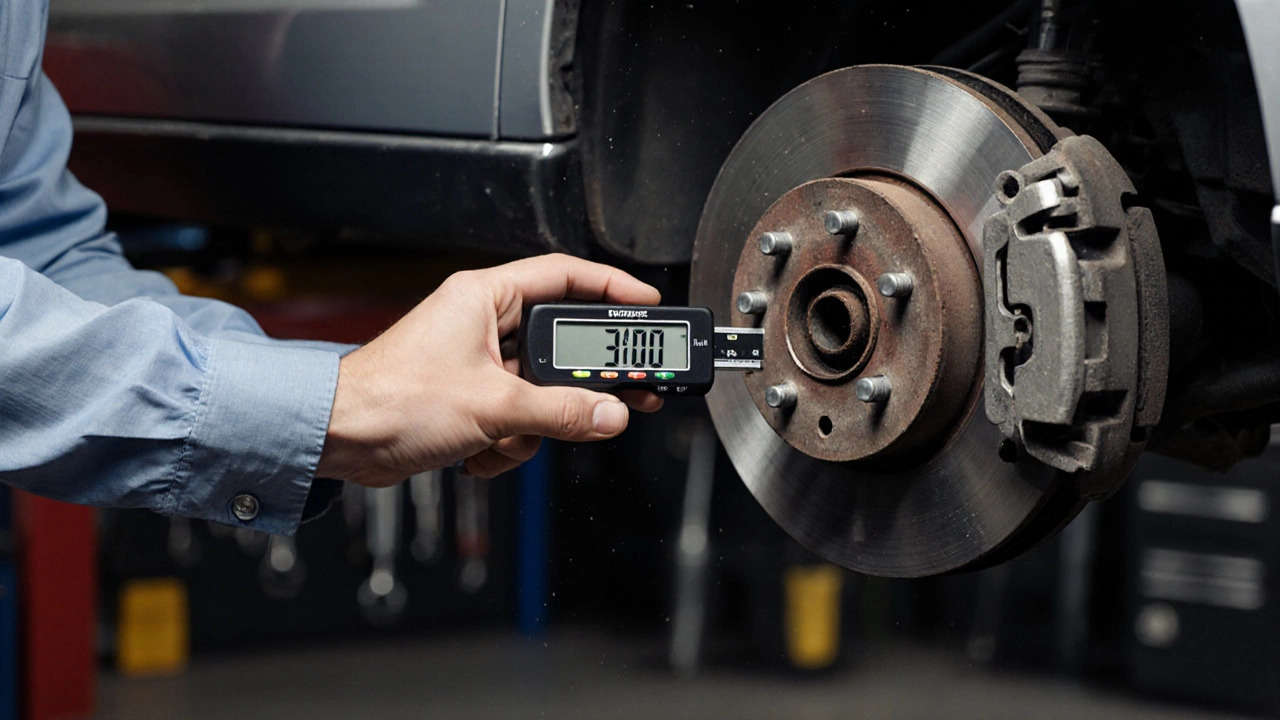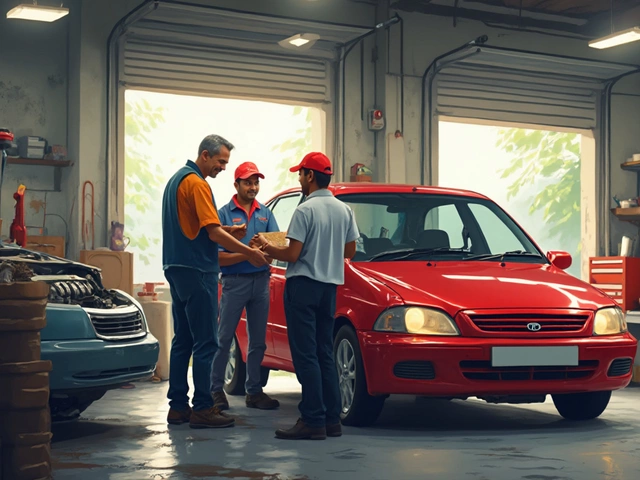Brake Pad Replacement Calculator
Vehicle Information
Estimated Replacement Mileage
Estimated Mileage:
--
kilometers
Based on 2024 Australian automotive workshop survey (1,200 service records)
Remember: Always check for warning signs like squealing, grinding noises, or reduced braking performance. Never rely solely on mileage estimates.
If you’re wondering how often to replace brake pads, you’re not alone. Drivers across Australia ask the same question, and the answer isn’t a one‑size‑fits‑all number. The right interval depends on how you drive, what you drive, and how well you look after your braking system.
How Brake Pads Work
When you press the pedal, a hydraulic force pushes the brake pads friction material that clamps onto the rotating surface of the brake rotor to slow the wheel. The heat generated converts kinetic energy into thermal energy, bringing the vehicle to a stop. Because they rely on friction, the pads wear down over time, just like a pair of shoes on a long walk.
Key Factors That Influence Pad Lifespan
Several variables determine how quickly your pads wear. Understanding them helps you estimate the next service date.
- Driving style Aggressive acceleration, late‑braking, and frequent stop‑and‑go traffic increase friction cycles.
- Vehicle weight Heavier cars or trucks demand more braking force, accelerating pad wear.
- Brake rotor condition Rough or warped rotors create uneven contact, grinding the pads faster.
- Brake fluid quality Old or contaminated fluid reduces hydraulic efficiency, causing the pads to work harder.
- Climate and road conditions Dusty roads or frequent rain can embed particles that act like sandpaper on the pad surface.

Typical Replacement Intervals
While manufacturers often quote a range of 30,000-70,000 km, real‑world data shows a clearer picture when you break it down by vehicle type and usage.
| Vehicle Category | Light City Driving | Mixed Suburban | Heavy Highway |
|---|---|---|---|
| Compact cars (e.g., Toyota Corolla) | 45,000 | 35,000 | 30,000 |
| Sedan / midsize (e.g., Mazda 6) | 40,000 | 30,000 | 25,000 |
| SUV / crossover (e.g., Hyundai Tucson) | 35,000 | 28,000 | 22,000 |
| Pickup / light truck (e.g., Toyota Hilux) | 30,000 | 24,000 | 20,000 |
| Performance cars (e.g., Subaru WRX) | 25,000 | 20,000 | 15,000 |
These numbers come from a 2024 Australian automotive workshop survey covering 1,200 service records. They illustrate why a city commuter might get away with 45000km, while a weekend track enthusiast may need new pads every 15000km.
Warning Signs Your Pads Need Replacing
Don’t wait for the mileage counter. Look for these red flags during regular drives.
- Squealing or high‑pitched squeak when braking - often the wear indicator a thin metal tab that contacts the rotor when the pad material thins below a safe limit is contacting the surface.
- Grinding noise - the metal backing is now touching the rotor, a sign of severe wear.
- Pulsating brake pedal - could be a warped brake rotor the disc that the pad clamps onto.
- Longer stopping distances - watch your stopping distance the distance a vehicle travels after the brakes are applied increase by even a few metres.
- Visual inspection: less than 3mm of pad material remaining.
DIY Pad Inspection Checklist
- Park on level ground, engage the handbrake, and turn off the engine.
- Remove the wheel using a lug wrench - most cars require a 19‑mm or 21‑mm socket.
- Locate the brake caliper the hydraulic component that pushes the pads onto the rotor. The pads sit on either side of the rotor.
- Measure pad thickness with a digital caliper; anything under 3mm means it’s time for replacement.
- Inspect the rotor surface for scoring or rust. Light surface rust can be cleaned; deep grooves require resurfacing or a new rotor.
- Re‑install the wheel, torque the lug nuts to the manufacturer’s spec (usually 100-130Nm for passenger cars).
If you’re uncomfortable removing wheels, most service centres will perform a visual check for free.

Consequences of Ignoring Worn Pads
Driving with exhausted pads isn’t just noisy - it’s dangerous.
- Increased stopping distance: Studies from the Royal Automobile Club of Victoria (RACV) show a 15% rise in stopping distance when pad thickness falls below 3mm. \n
- Rotor damage: The metal backing can gouge the rotor, leading to costly replacements. A new rotor can cost $300-$600, whereas a set of pads is typically $80-$150.
- Brake fluid overheating: Excess friction raises the temperature in the brake lines, potentially boiling the fluid and causing brake fade.
- Legal liability: In NSW and Victoria, driving a vehicle with defective brakes can result in fines and insurance complications.
Tips to Extend Pad Life
Good habits can push the replacement clock further.
- Brake early and gently. Allowing the vehicle to slow naturally before applying full pressure reduces heat buildup.
- Avoid riding the brake on long downhill stretches. Use engine braking or a lower gear.
- Keep the brake system clean. Remove dust and road grit with a brake cleaner spray during routine washes.
- Schedule a brake fluid flush every 2years or 30,000km to maintain hydraulic performance.
- Consider high‑performance ceramic pads if you frequently drive in hilly terrain; they resist dust buildup and heat better than organic pads.
Frequently Asked Questions
How many kilometers can I realistically expect from my brake pads?
Most passenger cars see pad wear between 30,000 and 50,000km under mixed driving conditions. Heavy‑duty trucks or performance cars often need replacement sooner, around 15,000-25,000km.
Do ceramic pads last longer than semi‑metallic ones?
Ceramic pads generally last 20‑30% longer because they produce less dust and handle heat better. However, they can be more expensive and may not be ideal for very heavy vehicles.
Can I replace brake pads myself, or should I go to a workshop?
If you have basic tools and are comfortable lifting the car, a DIY replacement is doable. The critical step is to properly torque the wheel nuts and re‑bleed the brake system if air gets in.
What does a squealing brake sound actually mean?
A high‑pitched squeal usually indicates the wear indicator is contacting the rotor. It’s a built‑in alarm that the pad thickness has reached the safety limit.
Will cold weather affect brake pad wear?
Cold temperatures can make brake fluid slightly thicker, requiring a bit more pedal effort, but they don’t significantly change the wear rate. The bigger issue in winter is road salt, which can cause corrosion on rotors.




